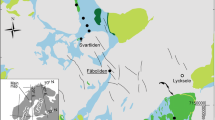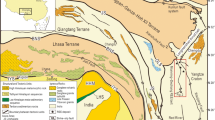Summary
A variety of alteration styles is associated with Cu, Ni and platinum-group element deposition in the Onaping-Levack area of the North Range of the Sudbury Structure. Two significant alteration assemblages are amphibole (actinolite) + epidote + chlorite + quartz ± albite ± K-feldspar ± calcite adjacent to Cu-rich veins in the Deep Copper Zone of Strathcona mine and the nearby Barnet property, and amphibole (actinolite to ferro-actinolite) + epidote + titanite + pentlandite + pyrite ±quartz ± magnetite in the Fraser mine Epidote Zone. The concentrically zoned Epidote Zone alteration has been further subdivided into facies that range from epidotized Footwall Breccia through actinolite-bearing rocks with few vestiges of original Footwall Breccia textures, to the most intensely altered magnetite-rich facies. Higher Fe3+ content in epidote in the most intensely altered rocks is compatible with the evolution of more oxidized fluids with time. Fe and Ni, in addition to Cu and PGE, have been mobilized. The 2- (L + V) and 3- (L + V + SC) phase fluid inclusions are similar in each of the deposit locations. Temperatures of first ice melting range from −64.9 to -42.3°C, indicating that the trapped fluids may be modelled in the system H2O-NaCl-CaCl2. Average salinities are high, between 20.8 to 34.4 NaCl wt.% eq., and show considerable overlap for each deposit. Isochores calculated from these data show a decrease in temperature range from the Epidote Zone (230 to 340°C) through Barnet (210 to 295°C) to the most distal Deep Copper Zone (175 to 280°C). The Cl-rich fluids deposited Cu and platinum-group elements in the Deep Copper Zone as a result of this thermal gradient. The high salinity fluid inclusions of the Sudbury North Range are similar to those from other high and intermediate temperature Cu-Ni-PGE deposits, and suggest that they were the result of late-stage hydrothermal activity within contact units of the Sudbury Igneous Complex.
Zusammenfassung
Platingruppen-Elementen im Onaping-Levack-Gebiet der North Range der Sudburystruktur verbunden. Zwei signifikante Mineralassoziationen sind Amphibol (Aktinolith) und Epitot + Chlorit + Quarz + Albit ± K-Feldspat ± Calcit in der Nähe kupferreicher Gänge der Deep Copper Zone der Stratcona Mine und dem nahegelegenen BarnetVorkommen. In der Epidot-Zone der Fraser-Mine kommen Amphibol (Aktinolith -Ferroaktinolit) + Epidot + Titanit + Pentlandit + Pyrit + Quarz + Magnetit vor. Die konzentrisch zonierte Alteration der Epidotzone wurde weiter unterteilt in Facies, die von der epidotisierten Liegend-Brevkzie über Aktinolith-führende Gesteine mit Resten entsprechend der Entwicklung zunehmend oxidierter Fluide. Fe und Ni sind zusätzlich zu Cu und PGE mobilisiert worden. Die 2- (L + V) und 3- (L + V + SC) Fluid-Einschlüsse sind in jeder Lokalität ähnlich. Die Temperaturen des ersten Schmelzens von Eis schwanken von −64.9 bis −42.3 °C, und dies weist darauf hin, daß diese Fluide dem System H2O-NaCl-CaCl2 angehören. Die durschnittlichen Salinitäten sind hoch, zwischen 20.8 und 34.4 NaCl wt.% und zeigen beträchtliche Überschneidungen für jede Lagerstätte. Isochoren, die aus diesen Daten berechnet wurden, zeigen eine Abnahme der Temperaturen von der Epidot-Zone (230–340°C) durch Barnet (210–295°C) zu der am weitesten entfernten Deep Copper Zone (175–280°C). Die Cl-reichen Fluide lagerten, durch diesen thermalen Gradienten bestimmt, Kupfer-und Platingruppenelemente in der Deep Copper Zone ab. Die Fluid-Einschlüsse mit hoher Salinität der Sudbury North Range sind denen von anderen Kupfer-Nickel-PGE-Lagerstätten, die bei hohen bis intermediären Temperaturen gebildet wurden, ähnlich. Dies weist darauf hin, daß sie das Ergebnis von später hydrothermaler Aktivität in den Kontaktzonen des Sudbury-Komplexes sind.
Similar content being viewed by others
References
Abel MK (1981) The structure of the Strathcona Mine copper zone. Can Inst Min Metal Bull 74: 89–97
——Buchan R, Coats CJA, Penstone ME (1979) Copper mineralization in the footwall complex, Strathcona mine, Sudbury, Ontario. Canad Mineral 17: 275–286
Ballhaus CG, Stumpfl EF (1986) Sulfide and platinum mineralization in the Merensky Reef evidence from hydrous silicates and fluid inclusions. Contr Mineral Petrol 94: 193–204
Barnett ES, Tirschmann PA (1989) Barnet Project Diamond Drill Summary Report. Falconbridge Limited Exploration Internal Report, 44 p
Coats CJA, Snajdr P (1984) Ore deposits of the North Range, Onaping-Levack area, Sudbury. In: Pye EG, Naldrett AJ, Giblin PE (eds) The Geology and Ore Deposits of the Sudbury Structure. Ont Geol Surv Spec Vol 1: 328–346
Cowan JC (1968) Geology of the Strathcona ore deposit. Can Inst Min Metal Bull 61: 38–54
Crawford ML (1981) Phase equilibria in aqueous fluid inclusions. In:Hollister LS, Crawford ML (eds) Fluid Inclusions: Applications to Petrology. Min Assoc Can Short Course Handbook 6: 41–63
Crerar DA, Barnes HL (1976) Ore solution chemistry V. Solubilities of chalcopyrite and chalcocite assemblages in hydrothermal solution at 200° to 350°C. Econ Geol 71: 772–794
Farrow CEG, Sweeny JM (1990) Barnet Property Trench Report. Falconbridge Limited Exploration Internal Report, 20 p
Fleet ME (1977) Origin of disseminated copper-nickel sulfide ore at Frood, Sudbury, Ontario. Econ Geo1 72: 1449–1456
—— (1979) Partitioning of Fe, Co, Ni, and Cu between sulfide liquid and basaltic melts and the composition of Ni-Cu sulfide deposits-a discussion. Econ Geol 74: 1517–1519
Foy R (1989) Longvack Diamond Drill Report. Falconbridge Limited Exploration Internal Report, 30 pGreenman L (1970) The petrology of the footwall breccias in the vicinity of the Strathcona
Hoffman EL, Naldrett AJ, Alcock RA, Hancock RGV (1979) The noble metal content of ore in the Levack West and Little Stobie mines, Ontario. Canad Mineral 17: 437–451
Johan Z, Watkinson DH (1987) Phase fluide riche en Na-Cl-H-O-N et son rôle dans le concentration des éléments groupe de platine et de la chromite: “Upper Critical Zone“, complexe de Bushveld. In: Guides de prospection pour les gisements de platinoides dans les complexes ophiolitiques et stratifiés. Rapport final: Commission des Communautés Européennes: 61–85
Lausen C (1930) Graphic intergrowth of niccolite and chalcopyrite, Worthington Mine, Sudbury. Econ Geol 25: 356–364
Li C, Naldrett AJ (1989) PGE studies in the footwall at Sudbury. Ont Geol Surv Misc Paper 143: 104–113
Lochhead DR (1955) The Falconbridge ore deposit. Econ Geol 50: 42–50
Loucks RR (1976) Platinum-gold-copper mineralization, central Medicine Bow Mountains, Wyoming. M Sc Thesis Colorado State Univ
Marshall DD (1990) Pressure, temperature, composition and state of the fluid during silver arsenide vein formation, Cobalt, Ontario. M Sc Thesis Carleton Univ
McCallum ME, Loucks RR, Carlson RR, Cooley EF, Doerge TA (1976) Platinum metals associated with hydrothermal copper ores of the New Rambler mine, Medicine Bow Mountains, Wyoming. Econ Geol 71: 1429–1450
Mountain BW, Wood SA (1988) Chemical controls on the solubility, transport, and deposition of platinum and palladium in hydrothermal solutions: A thermodynamic approach. Econ Geol 83: 492–510
Naldrett AJ (1989) Magmatic Sulfide Deposits. Oxford Monographs on Geology and Geophysics No. 14, Clarendon Press, New York, 186 p
—— (1979) Partitioning of Fe, Co, Ni, and Cu between sulfide liquid and basaltic melts and the composition of Ni-Cu sulfide deposits-a reply and further discussion. Econ Geol 74: 1520–1528
Naldrett AJ, Innes DG, Sowa J, Gorton MP (1982) Compositional variations within and between five Sudbury ore deposits. Econ Geol 77: 1519–1534
——Kullerud G (1967) A study of the Strathcona mine and its bearing on the origin of the nickel-copper ores of the Sudbury district, Ontario. J Petrol 8: 453–531
Nyman MW, Sheets RW, Bodnar RJ (1990) Fluid-inclusion evidence for the physical and chemical conditions associated with intermediate-temperature PGE mineralization at the New Rambler deposit, southeastern Wyoming. Canad Mineral 28: 29–638
Oakes CS, Bodnar RJ, Simonson JM (1990) The system NaCl-CaCl2-H2O. I. The ice liquidus at 1 atm. total pressure. Geochim Cosmochim Acta 54: 603–610
Ohnenstetter D, Watkinson DH, Dahl R (1992) Zoned hollingworthite from the Coldwell Complex, northwestern Ontario. Amer Mineral 76: (in press)
Patterson EF (1979) The Sudbury Sublayer. Canad Mineral 17: 257–274
Roedder E (1984) Fluid inclusions. Mineral Soc Amer Rev Mineralogy 12: 664 p
Rowell WF, Edgar AD (1986) Platinum-group element mineralization in a hydrothermal Cu-Ni sulfide occurrence, Rathbun Lake, northeastern Ontario. Econ Geol 81: 1272–1277
Schiffries CM, Skinner BJ (1987) The Bushveld hydrothermal system: field and petrologic evidence. Amer J Sci 287: 566–595
Souch BE, Podolsky T, Geological Staff (1969) The sulfide ores of Sudbury: their particular relationship to a distinctive inclusion-bearing facies of the nickel Irruptive. In:Wilson HDB (ed) Magmatic Ore Deposits. Econ Geol Mon 4: 252–261
Springer G (1989) Chlorine-bearing and other uncommon minerals in the Strathcona Deep Copper Zone, Sudbury district, Ontario. Canad Mineral 27: 311–313
Sweeny JM, Farrow CEG (1990) Geology of the Morgan Property. Falconbridge Limited Exploration Internal Report, 32 p
—Meecham R, Spark R, Farrow CEG (1990) Geology of the Pike Lake-Longvack properties. Falconbridge Limited Exploration Internal Report, 22 p
Tellier ML, Brugmann GE, Naldrett AJ (1991) Gabbro-hosted PGE mineralization in the Lac-des-Iles Complex: A geochemistry and fluid inclusions study. Geol Assoc CanadMineral Assoc Canad-Soc Econ Geol Joint Annual Meeting Programme with Abstracts 16: A123
Tirschmann PA (1989) Barnet Project Geology Report, Levack Township. Falconbridge Limited Exploration Internal Report, 24 p
Vanko DA, Bodnar RJ, Sterner SM (1988) Synthetic fluid inclusions: VIII. Vapor-saturated halite solubility in part of the system NaCl-CaCl2-H2O, with application to fluid inclusions from oceanic hydrothermal systems. Geochim Cosmochim Acta 52: 2451–2456
Volfinger M, Robert JL, Vielzeuf D, Neiva AMR (1985) Structural control of the chlorine content of OH-bearing silicates (micas and amphiboles). Geochim Cosmochim Acta 49: 37–49
Wandke A, Hoffman R (1924) A study of Sudbury ore deposits. Econ Geol 19: 169–204
Watkinson DH (1990) Platinum-group minerals in Cu-rich sulfides from some North American mafic-ultramafic rock complexes. Second Symp on Modern Mineral, Mineral Soc Korea, 37–51
—Melling DR (1992) Hydrothermal origin of platinum-group mineralization in low temperature copper sulfide-rich assemblages, Salt Chuck intrusion, Alaska. Econ Geol 87: (in press)
— —Farrow CEG (1991) Origin of platinum-group mineralization in low-temperature copper-sulfide assemblages, Salt Chuck intrusion, Alaska. Abstract, Sixth Internat Platinum Symp, Perth, Australia
—Ohnenstetter D (1991) Hydrothermal origin of platinum-group mineralization in the Two Duck Lake intrusion, Coldwell Complex, northwestern Ontario. Canad Mineral 30 (in press)
Zhang Y, Frantz JD (1987) Determination of the homogenization temperatures and densities of supercritical fluids in the system NaCl-KCl-CaCl2-H2O using synthetic fluid inclusions. Chem Geol 64: 335–350
Author information
Authors and Affiliations
Additional information
With 5 Figures
Rights and permissions
About this article
Cite this article
Farrow, C.E.G., Watkinson, D.H. Alteration and the role of fluids in Ni, Cu and platinum-group element deposition, Sudbury Igneous Complex contact, Onaping-Levack area, Ontario. Mineralogy and Petrology 46, 67–83 (1992). https://doi.org/10.1007/BF01160703
Received:
Accepted:
Issue Date:
DOI: https://doi.org/10.1007/BF01160703




